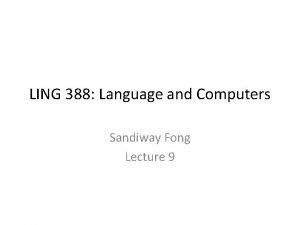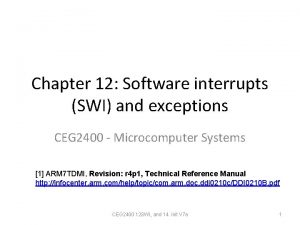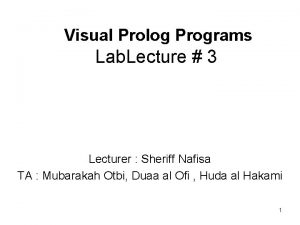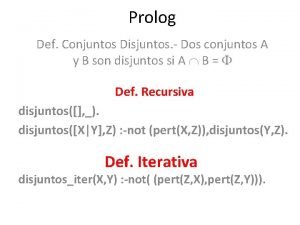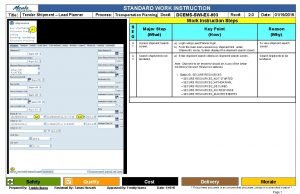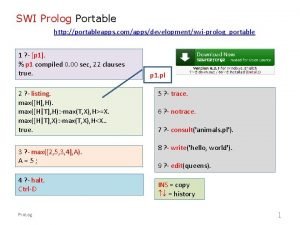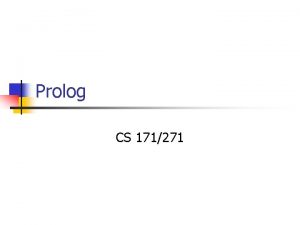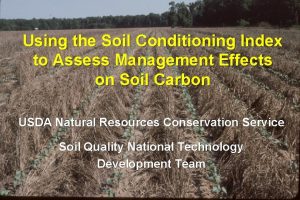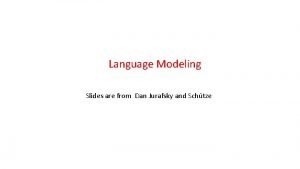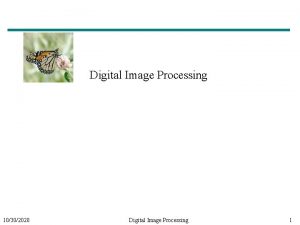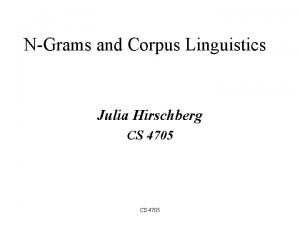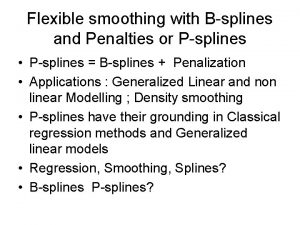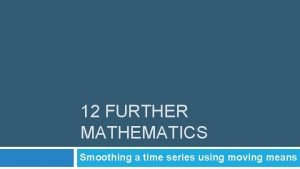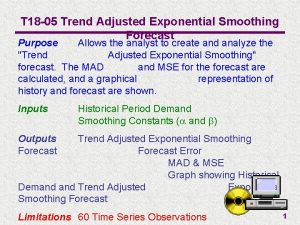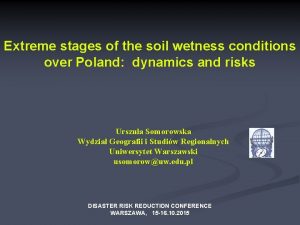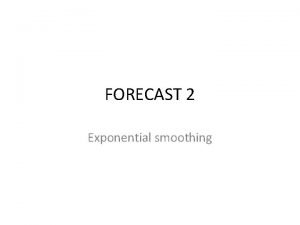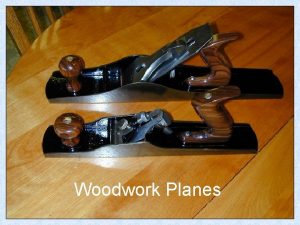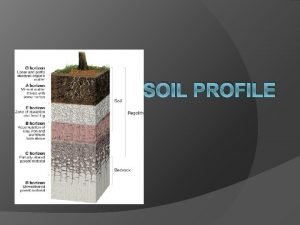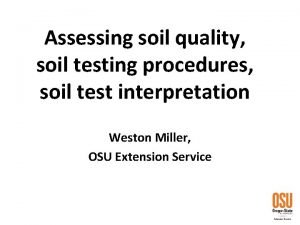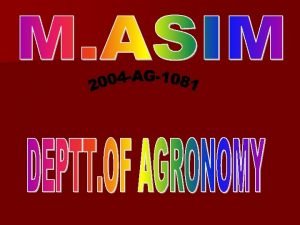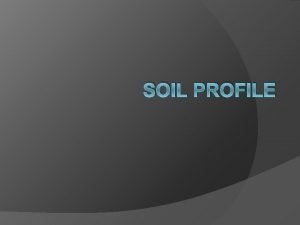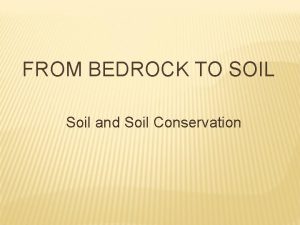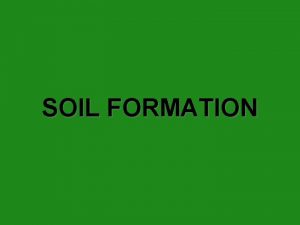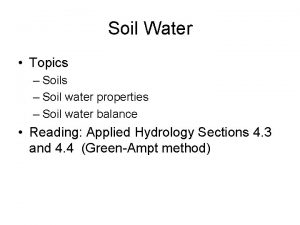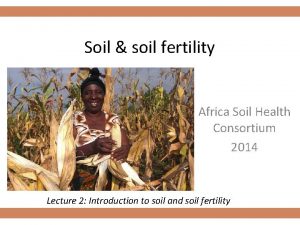Smoothing of Soil Wetness Index SWI in ALADINLACE





















- Slides: 21

Smoothing of Soil Wetness Index (SWI) in ALADIN/LACE domain Stjepan Ivatek-Šahdan Meteorological and Hydrological Service of Croatia ivateks@cirus. dhz. hr 13 th ALADIN Workshop, Prague, November 24 th-28 th 2003

Problem: hot spots during the afternoon - problem in LACE 2 m Temperature forecasts during the June 2002 - same problem in ARPEGE and ALADIN/FRANCE 2 m Temperature SWI 13 th ALADIN Workshop, Prague, November 24 th-28 th 2003

How Optimum Interpolation surface analysis (operational global surface analysis) works? Optimum Interpolation of T 2 m and RH 2 m using SYNOP observations interpolated at the model grid-point (by a 2 m analysis) D T 2 m = T 2 ma - T 2 mf D RH 2 m = RH 2 ma - RH 2 mf Correction of surface parameters (Ts, Tp, Ws, Wp) using 2 m increments between analysed and forecasted values Sequential analysis (every 6 h) Tsa - Tsf = D T 2 m Tpa - Tpf = D T 2 m / 2 p Wsa - Wsf = Ws. T D T 2 m + Ws. RH D RH 2 m Wpa - Wpf = Wp. T D T 2 m + Wp. RH D RH 2 m t RH 2 m Wp/s. T/RH = f (t, veg, LAI/Rsmin, texture, atm. cds. ) -OI coefficients 13 th ALADIN Workshop, Prague, November 24 th-28 th 2003 t Wp t 6 -h 12 -h 18 -h 0 -h

The link between soil moisture and atmosphere The main interaction of soil moisture and atmosphere is due to evaporation and vegetation transpiration processes. E Eg Etr 0 <SWI< 1 Ws Wp Wp vegetation Ws bare ground WS WP - Surface soil water content Total soil water content veg - Percentage of vegetation dz - Soil depth or reservoir depth 13 th ALADIN Workshop, Prague, November 24 th-28 th 2003

Soil Wetness Index (SWI) - I - represents the hydric stress of the vegetation - SWI ≤ 0 - transpiration of the plants is zero (dry soils) - SWI ≥ 1 - vegetation evaporate at the maximal rate (wet soils) Definition: Smoothing of SWI (land points, without snow cower & ice in a ground) few checks 13 th ALADIN Workshop, Prague, November 24 th-28 th 2003

Soil Wetness Index (SWI) - II Changes of SWI during the day There are no some important changes between analysis and forecasts! 13 th ALADIN Workshop, Prague, November 24 th-28 th 2003

Smoothing of Soil Wetness Index (SWI) - I - smoothing: with data from 5 -ALADIN 7 -ARPEGE nearest grid points; - radius: 4. 1 km (1/3 of grid size) or 6. 1 km (1/2 of grid size); - number of smoothing: 10, 21 and 30; - XXSMRR: smoothing is performed XX times, radius RR*0. 1 km; winter - 30 SM 61 - 30 smoothing with radius 6. 1 km. 13 th ALADIN Workshop, Prague, November 24 th-28 th 2003

Smoothing of Soil Wetness Index (SWI) - II SWI for 19 th June 2002 00 UTC - summer example 13 th ALADIN Workshop, Prague, November 24 th-28 th 2003

Smoothing of Soil Wetness Index (SWI) - III 13 th ALADIN Workshop, Prague, November 24 th-28 th 2003

Experiments and some results I - 12 days are chosen for testing: - 6 days in June 2002 and - 6 days in year 2003, 3 in January, 2 in April and 1 in May. - forecasts with ALADIN AL 25 T 1_op 2 in Croatia with different initial files For all Analyses no changes bigger than ± 0. 5 °C for T 2 m or ± 2 % H 2 m. 3 days in January 2003 (07 th, 13 th and 16 th) - 7 th - lot of snow in Croatia and precipitation in South Europe, max T 2 m around 0°C; - 13 th and 14 th - max T 2 m around 0°C, some sunny periods; - 16 th and 17 th - lot of sunshine, without rain for continental Europe, max T 2 m > 0°C. T 2 m: more than 600 points changes max 5 points bigger than 0. 5 °C for each forecast. H 2 m: more than 600 points changes max 40 points bigger than 5 % for each forecast. There is no important impact for January. 1 st spring example, 2 nd and 5 th April 2003 - 2 nd and 3 rd - moving cyclone with frontal system over the Europe; - 2 nd sunny in Central and East Europe; - amplitude of T 2 m in continental Croatia 2 nd ~20 °C, 3 rd - west Croatia < 5 °C. - 5 th and 6 th West Europe no precipitation. T 2 m amplitude > 10 °C in South Europe. 13 th ALADIN Workshop, Prague, November 24 th-28 th 2003

Experiments and some results II - T 2 m less than 5 % p. changes > ± 0. 5 °C, just 1 % > 2 °C; - H 2 m max. 20 % p. changed > ± 2 %, few times H 2 m changed > 10 %. The Change is greater than for winter but not very big. 2 nd spring example, 6 th May 2003 - 6 th and 7 th May, front moving over West Europe, and than stop on Alps, other parts of Europe T 2 m amplitude ~ 20 °C, lot of sunshine. Hot spots over a Central Europe, smaller for 7 th. - T 2 m max. 22 % p. changed > ± 0. 5 °C, and 2 % > ± 2 °C ; - H 2 m max. 45 % p. changed > H 2 m ± 2 %, and 9 % > ± 10 %. For this period impact of smoothing of SWI is relatively big. 13 th ALADIN Workshop, Prague, November 24 th-28 th 2003

Experiments and some results III Results for problematic period in June 2002 - period from June 15 th - 21 st 2002 - very hot period T 2 m in Central Europe > 30 °C, with extreme values from the beginning of measuring. Very hot period for West Europe too, but not during the whole period. Generally when the number of smoothing or radius of smoothing are increased, values in more and more points change for more than ± 0. 5 °C or ± 2 %, forecasts. - T 2 m maximum 53 % p. changed > ± 0. 5 °C, and 9 % > ± 2 °C; - H 2 m maximum 65 % p. changed > ± 2 %, and 17 % > ± 10 %. In this period, maximum changes of H 2 m and T 2 m were noticed in all examples. In summer examples, in areas with big gradients of surface temperature improvement in T 2 m forecast is really big, in same points for more than 2 °C, for radius of smoothing 6. 1 km and for 21 or 30 times of smoothing, for 12 and 36 hrs forecast. 13 th ALADIN Workshop, Prague, November 24 th-28 th 2003

Experiments and some results IV 13 th ALADIN Workshop, Prague, November 24 th-28 th 2003

Experiments and some results V Comparison of results against SYNOP data If the points are dark yellow, orange or red smoothing forecast is better. comparison of absolute errors for T 2 m If the points are green, light or dark blue operational forecast is better. 13 th ALADIN Workshop, Prague, November 24 th-28 th 2003

Experiments and some results VI 13 th ALADIN Workshop, Prague, November 24 th-28 th 2003

Experiments and some results VII RMS and Bias for T 2 m For June 2002 T 2 m RMS is usually better for smoothed SWI, the differences are higher for 12, 36 and 18 hrs forecast, maximum for RMS=0. 33 °C. BIAS is usually less than zero. Operational run is better for BIAS and difference is higher for 12, 18, 36 and 42 hrs forecasts. Maximum difference for BIAS=0. 37 °C. 13 th ALADIN Workshop, Prague, November 24 th-28 th 2003

Experiments and some results VIII Comparison of results against SYNOP data If the points are dark yellow, orange or red smoothing forecast is better. comparison of absolute errors for H 2 m If the points are green, light or dark blue operational forecast is better. 13 th ALADIN Workshop, Prague, November 24 th-28 th 2003

Experiments and some results IX RMS and Bias for H 2 m For June 2002, with very high temperatures, RMS is better for runs with smoothed SWI, maximum improvement of RMS for H 2 m is 0. 022. For H 2 m BIAS operational forecast is often better than run with smoothed SWI, maximum difference for BIAS=0. 024. 13 th ALADIN Workshop, Prague, November 24 th-28 th 2003

Statistics for June 2002 against oper - “+++” - big improvement of forecast (greater than 2 °C or 5 %) ; - “++” - improvement (1 -2 °C or 2 -5 %) and; - “+” - small improvement in forecast (0. 5 -1 °C or 0. 5 -2 %). - Same is for “-” classes, but for worse forecasts. Number in table > 0 more points with better forecast. “ 1*+++1*+1*-1*---” same weight for all classes; “ 2*+++1. 5*++1*+1*-2*--3*---” weight for worst forecast is little bit bigger; “ 2*+++1. 5*++1*+1*-3*--4*---” bigger weight for worst forecast. Comparison of number of points with better and worse scores of operational run with smoothed runs, with different weights, for all days (15 -20) and all forecasts (00, 06, …, 48) 13 th ALADIN Workshop, Prague, November 24 th-28 th 2003

Statistics for June 2002 against 21 SM 61 smoothing Number of points with better and worse scores for T 2 m and H 2 m in comparison of 20 SM 61 with other runs (OPER and other smoothings: 10 SM 61, 21 SM 41, 30 SM 41 and 30 SM 61), sum for all forecasts hours: 00, 06, 12… 48 UTC, and for whole period, 15 th-20 th of June 2002 Comparison of number of points with better and worse scores for T 2 m of 20 SM 61 with 30 SM 61 smoothed run, with different weights, |err(21 SM 61)|-|err(30 SM 61)|, 15 th-20 th of June 2002 13 th ALADIN Workshop, Prague, November 24 th-28 th 2003

Conclusion - during hot summer days, hot spots appear in T 2 m, caused by small scales features in the soil moisture, - problems in surface analysis and convective precipitation, - winter - small changes after smoothing; - summer - increasing number and radius of smoothing of SWI, SWI becomes smooth, maybe 30 SM 61 is to smooth, - with smoothed SWI - no more big gradients in T 2 m field, some points are colder for more than 2 °C, - January and April - no important changes in RMS and BIAS, - 15 th – 20 th June 2002 RMS is better for smoothed SWI, maximum improvement of RMS for H 2 m is 0. 022, operational BIAS is better, maximum difference for BIAS=0. 024. For T 2 m RMS is usually better for smoothed SWI, highest differences are for 12, 36 and 18 hrs forecast, maximum for RMS=0. 334 °C. For all experiments BIAS is usually less than zero. Operational run better for BIAS and difference is higher for 12, 18, 36 and 42 hrs forecasts, maximum difference for BIAS=0. 369 °C. -proposed solution: to use 21 SM 61 smoothing, smoothing applied 21 times and 6. 1 km radius of smoothing (half of the horizontal grid), - test with longer parallel, - ifth the smoothing of SWI is used in ARPEGE it is not needed in ALADIN. 13 ALADIN Workshop, Prague, November 24 th-28 th 2003
 Swi prolog examples
Swi prolog examples Swi-prolog tutorial
Swi-prolog tutorial Swi interrupt
Swi interrupt Visual prolog tutorial
Visual prolog tutorial Swi prolog documentation
Swi prolog documentation Swi-prolog tutorial
Swi-prolog tutorial Swi(standard work instructions)
Swi(standard work instructions) Prolog portable
Prolog portable Download prolog
Download prolog Living soil vs dead soil
Living soil vs dead soil Four major spheres of the earth
Four major spheres of the earth Soil conditioning index
Soil conditioning index Consistancy index
Consistancy index Stupid backoff smoothing
Stupid backoff smoothing Spatial smoothing filter
Spatial smoothing filter Good turing smoothing
Good turing smoothing Vowel sound phonetics
Vowel sound phonetics How to calculate exponential smoothing
How to calculate exponential smoothing Flexible smoothing with b-splines and penalties
Flexible smoothing with b-splines and penalties Four mean smoothing with centring
Four mean smoothing with centring Manajemen konflik dalam keperawatan
Manajemen konflik dalam keperawatan Trend adjusted exponential smoothing
Trend adjusted exponential smoothing
